Ombria in Shadow

McKillip, Patricia A. Ombria in Shadow. New York: Ace Books, 2002. ISBN 0-441-00895-X, hc, 298 pp., $22.95.

(This review originally appeared in Mythprint 39:10 (#247) in October 2002.)
Reviewed by Matthew Scott Winslow
Patricia McKillip consistently writes wonderful novels. I hesitate to use the word “excellent” because how would I then describe a novel that excels her most recent novels? Her latest endeavor, Ombria in Shadow, does just that, though. Her previous recent novels (from, say, The Book of Atrix Wolfe on to The Tower at Stony Wood) have been consistently nominated for the Mythopoeic Fantasy Award long list, and nearly all of them have made the short list, as well. With such a prestigious track record, I was not expecting to be ‘wowed’ beyond what one usually expects from a Patricia McKillip novel.
I was wowed, however. From the opening chapter through to the last page, I was captivated, not only by the lush, rich language that McKillip is known for, but by an engaging and enthralling story and characters that were more immediate and real than McKillip has created since perhaps The Forgotten Beasts of Eld. Ombria in Shadow takes place entirely within the city-state of Ombria. The novel opens with the death (or is it murder?) of the ruling prince. His mistress is comforting his young son when she realizes that she would probably be top of the list to be done away with when the wicked Domina Pearl (also known as the Black Pearl) assumes power as regent for the young princeling. She flees back to the tavern that her father owns.
Meanwhile, the prince dies and sure enough, Domina Pearl is declared regent to the young heir to the throne of Ombria. The members of the extended ruling family, however, are not pleased with this situation and want to put the bastard Ducon, cousin to the prince, on the throne. Ducon, however, realizes the extent of the Black Pearl’s reach, and instead keeps a low profile so that she will not kill the innocent princeling.
In the background of all this intrigue are the witch Faey, who creates magics and spells for those who can afford it, and who has been around Ombria for longer than even the incredibly ancient Domina Pearl can remember, and her orphan daughter, Mag. Faey tries to keep herself neutral, and tries to keep Mag that way also, telling her that she is a waxling and not human. Mag, however, quickly learns the truth, and gets herself ensnared in the intrigues of the court as she becomes enamored with Ducon.
In typical McKillip fashion, there is more going on between the lines than first meets the eye and all is not revealed until nearly the last page. But also in typical McKillip fashion, this duplicity and hiding is part of the charm of her writing. While reading the book, I did not feel in the slightest that I was being led on. The plotting and storytelling is such that one feels as if one is caught in the action as much as the characters are. There is no sense of knowing above the story what’s going on, but rather, the reader feels as if he were within the story with the characters: what they don’t know, the reader doesn’t know either. McKillip has a great skill for not making the reader feel as if there were an omniscient narrator pulling the strings.
As such, the story is refreshingly told. and the characters and plot unfold at an appropriate pace — not too fast, but not too slow — building to a conclusion that is just and fitting, but that doesn¹t feel epic in its proportions to the characters involved. They all know they’ve been involved in important events, but there is not a sense that the events are bigger than the people involved. When all is said and done, this is a story that makes itself believable by having characters that are believable in how they relate to the events of the story. And, of course, McKillip’s rich language is, as always, evident in nearly every sentence of the book.
This is a wonderful book and I wouldn’t be surprised to see it land on the short list for the Mythopoeic Fantasy Award this year.
